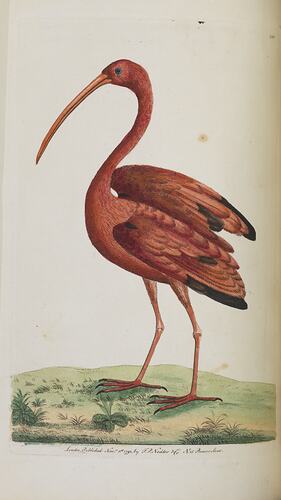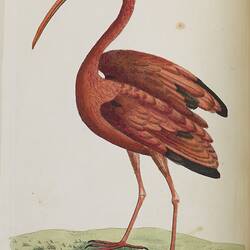Summary
Full title: 'The naturalists' miscellany: or coloured figures of natural objects; drawn and described immediately from nature.'
'The naturalists' miscellany', written by George Shaw (1751-1813) and illustrated by Frederick Polydore Nodder (1751-1800), was was a scientific series published in monthly instalments from August 1789 to July 1813, ceasing when Shaw died. The series is mainly devoted to zoological subjects, and includes an assortment of birds, animals, reptiles, insects and sea creatures.
Born in Buckinghamshire, and educated at Oxford, Shaw was a well-established naturalist. He was also an assistant lecturer, a co-founder of the Linnean Society, a fellow of the Royal Society, an assistant keeper of the natural history department at the British Museum and an author.
Frederick Polydore Nodder was an English illustrator, engraver, painter, and publisher. Nodder was the illustrator and publisher of 'The naturalist's miscellany' and after his death in 1800 his wife Elizabeth and son Richard continued his work on the series.
Shaw's life as a professional naturalist coincided with the early years of the colonisation of eastern Australia when many of the 'strange' creatures the colonists encountered were being sent back to England as specimens for naturalists like Shaw to study. Shaw and Nodder were responsible for publishing the first Western scientific descriptions and scientific names of some of Australia's most well-known animals. Having never visited Australia, Shaw and Nodder used pictures, illustrations and collected samples from the First Fleet voyage to describe and present animals in their works. During this time many of Australia's native animals were seen by Europeans for the first time, sometimes confounding scientists of the period.
'The naturalists' miscellany' was published in 287 monthly parts over 24 years. During its 24-year period it is thought that the authors only missed one monthly instalment, March 1795. At the front of every volume are two dedicatory pages; one in Latin and one in English. These pages mention George Shaw and Fredrick Nodder and in later volumes they mention Elizabeth Nodder. Each volume has an index (in both Latin and English) and a compilation index titled 'General indexes in Latin and English' was published for the set in 1813. All indexes contain plate numbers but no dates or part numbers.
The complete work contains 1064 hand-coloured copperplate engravings. Four additional engravings were prepared but the accompanying text was never written due to the passing of George Shaw. Some plates are numbered, some are unnumbered, and others have been misnumbered. After Frederick Nodder's death in 1800, the dating of plates became erratic and eventually petered out. The engravings are accompanied by descriptions written in the Linnaean manner, in both Latin and English.
When bound, volumes were arranged with the plates in numerical order alongside their accompanying texts. However, due to human error and missing plate numbers, some differences exist between individual sets. Some copies have errors in plate sequencing, missing plates, or the plate numbers given in the indexes do not match up to the number on the plate. Also found are indexing errors and inconsistencies in the way the title and dedicatory pages are bound.
Almost every instalment starts with a bird, but some instalments feature a mammal instead - this is thought to have happened due to inaccurate sequencing during the binding process.
Physical Description
The total work consists of 287 parts bound into 24 volumes (233 x 141mm). The series is half bound in tanned leather and grey buckram with gold linear decoration. Tightback binding. The text is printed on laid paper and the plates are printed on wove paper.
Significance
Shaw and Nodder were responsible for publishing the first Western scientific descriptions and scientific names of some of Australia's most well-known animals including the first scientific description of any species of kangaroo (1790). George Shaw's descriptions throughout the 'The naturalists' ?miscellany' contain awe and scepticism as he struggled to fit Australia's unfamiliar creatures into his understanding of the natural world.
In 1792 Shaw introduced the echidna (the Porcupine Ant-Eater) to the wider world. 'This extraordinary animal may well be considered amongst the most curious and interesting quadrupeds yet discovered... since it is not only an absolutely new and hitherto unknown species... but is also a most striking instance of that beautiful gradation, so frequently observed in the animal kingdom, by which creatures of one tribe or genus approach to those of a very different one.'
In 1799 Shaw described the platypus. Convinced the specimen was a hoax, with the bill of a duck sewn onto the body of something like a water rat, he wrote: 'Of all the Mammalia yet known it seems the most extraordinary... the perfect resemblance of the beak of a duck engrafted onto the head of a quadruped... it naturally excites the idea of some deceptive preparation by artificial means.'
The engravings featured in these works are now prized by collectors, resulting in plates being removed from some copies. This has made complete sets of 'The naturalists' miscellany' relatively rare.
More Information
-
Collecting Areas
-
Illustrator and publisher
-
Publisher
Elizabeth R. Nodder, 1789
The title pages of volumes 1-12 of 'The naturalist's miscellany' list George Shaw and F. P. Nodder as authors. Volume 13 lists E.R. Nodder after George Shaw and in volume 14, George Shaw's name is followed by E. & R. Nodder. The remaining volumes (15-24) have E. Nodder listed with George Shaw. -
Author
-
Illustrator
-
Illustrator
-
Category
-
Discipline
-
Type of item
-
References
Calaby, J H (1967), Australian Dictionary of Biography: Shaw, George (1751-1813), National Centre of Biography, Australian National University, viewed online: [Link 1] Dickinson, EC, Bruce, MD & Dowsett, RJ (2006), "Vivarium naturae or the naturalist's miscellany (1789-1813) by George Shaw: an assessment of the dating of the parts and volumes," Archives of Natural History, 33(2):322-343, [Link 2] Kearney, N (no date), A glimpse into the past, to enlighten the future of biodiversity on Earth, Museums Victoria, viewed online at: [Link 3] Royal Society of Tasmania (2014) The library at the end of the world?: natural science and its illustrators. Edited by A. Hansen and M. Davies. Hobart, Tasmania, Australia: Royal Society of Tasmania.
-
Keywords
Zoology, Art and history, Pictorial works, Animals, 18th century





